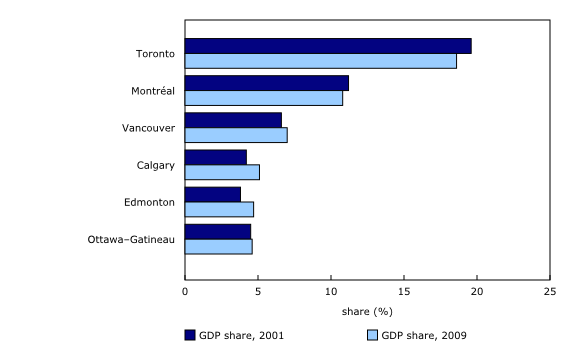Study: Metropolitan gross domestic product: Experimental estimates, 2001 to 2009
Archived Content
Information identified as archived is provided for reference, research or recordkeeping purposes. It is not subject to the Government of Canada Web Standards and has not been altered or updated since it was archived. Please "contact us" to request a format other than those available.
Released: 2014-11-10
About half of Canada's gross domestic product (GDP) is generated in the six census metropolitan areas (CMAs) with populations of one million or more: Toronto, Montréal, Vancouver, Calgary, Edmonton and Ottawa–Gatineau.
Traditionally, Statistics Canada has produced estimates of GDP nationally and by province, but not at the metropolitan level. With growing interest in measuring the dynamics of metropolitan economies, new experimental estimates of GDP by CMAs have been developed.
These include estimates of GDP over the 2001 to 2009 period for 33 CMAs and the non-metropolitan regions of the nine provinces with a CMA.
The new estimates reveal that, as with population, economic activity in Canada is predominately concentrated in cities. While accounting for 69% of Canada's population in 2009, CMAs generated about 72% of Canadian GDP.
To date, most analyses of metropolitan economies have relied on employment and income, indicators that measure the amount of and returns to labour used to produce goods and services, respectively. GDP includes the remuneration received by both labour and capital.
GDP provides a means to assess the importance and performance of metropolitan economies. How much metropolitan economies contribute to provincial and national output and how effectively inputs, like labour, are converted into output.
Toronto continues to be Canada's largest metropolitan economy, accounting for 19% of the national total. However, growth through the 2000s shifted towards western CMAs. The CMAs of Calgary and Edmonton, which combined have less than half of Toronto's population, together gained close to the same amount of GDP (+$62 billion versus +$71 billion) between 2001 and 2009.
Almost all the CMAs from Manitoba west (8 of 9) increased their GDP share, while a minority of CMAs from Ontario east (9 of 24) gained GDP share.
Note to readers
Estimates of gross domestic product (GDP) by metropolitan area can be obtained in CANSIM Table 381-5000. Furthermore, a data set with industry detail and additional measures of labour inputs can be accessed through the Canadian Centre for Data Development and Economic Research. A background description of the methodology used to estimate metropolitan GDP is available upon request.
The research article "Metropolitan Gross Domestic Product: Experimental Estimates, 2001 to 2009," part of the Economic Insights (Catalogue number11-626-X), is now available from the Browse by key resource module of our website under Publications.
Similar studies are also available in the Update on Economic Analysis module of our website.
Contact information
For more information, contact us (toll-free 1-800-263-1136; 514-283-8300; infostats@statcan.gc.ca).
To enquire about the concepts, methods or data quality of this release, contact Mark Brown (613-951-7292; mark.brown@statcan.gc.ca) or Luke Rispoli (613-951-6407; luke.rispoli@statcan.gc.ca), Economic Analysis Division.
- Date modified:


